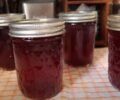The Art of Canning: Preserving Food for Convenience and Flavor

chicken
1
Canning food has been a time-honored tradition, practiced since the earliest days of human civilization. Just like our ancestors, who prepared for the winter by preserving their harvest, modern canning provides a way to enjoy seasonal produce and meats all year round. This method of food preservation not only ensures long-term storage but also offers the convenience of having ready-to-eat meals at hand.
The Tradition of Canning
Historically, families canned food to make the most of their harvests. In the past, children were even given time off from school to help with the fall harvest, ensuring that their families had enough food preserved for the winter months. This tradition has been passed down through generations, with each family adding their own touch to the process.
Modern Canning: Combining Tradition with Convenience
While canning has its roots in long-term food storage, today it also serves the purpose of convenience. For instance, when chicken breasts go on sale, you can take the opportunity to stock up and can them for future use. By canning chicken, you can create a variety of meals such as chicken salad, chicken pot pie, casseroles, and more, all from the comfort of your own pantry.
Preparing to Can Chicken
When canning chicken, it's important to think about how you'll use it later. Adding spices and seasonings during the canning process can enhance the flavor and make meal preparation easier. For example, adding garlic, salt, poultry seasoning, and thyme to your jars of chicken can make them perfect for a quick and tasty chicken salad or casserole.
Next time you can chicken, consider using different seasonings like cumin, chili powder, garlic, and oregano for Mexican-inspired dishes. This approach not only preserves the chicken but also infuses it with flavors that will make your meals even more delicious.

2
The Canning Process
Canning chicken is a straightforward process. Here's a step-by-step guide:
Prepare Your Jars and Chicken: Cut the raw, cold chicken into chunks and pack them tightly into jars, leaving about an inch and a half of headspace.
Add Seasonings: For each jar, add half a teaspoon of canning salt, thyme, poultry seasoning, and chopped garlic.
Add Liquid: Add just a tablespoon of water to each jar to help kickstart the creation of broth during the canning process.
Clean and Seal: Wipe the rims of the jars with vinegar to ensure a clean seal, then place the lids and rings on the jars finger-tight.

3
Process in the Canner: Place the jars in a pressure canner with three quarts of room temperature water. Allow the canner to vent for 10 minutes, then process at 10 pounds of pressure for 75 minutes.

4
By following these steps, you'll have jars of flavorful chicken ready for a variety of dishes. The chicken will create its own broth, making it even more convenient to use.
The Benefits of Home Canning
Canning at home offers numerous benefits. It allows you to avoid preservatives and additives found in store-bought canned goods, ensuring that your food is healthier and tastier. Moreover, having a stock of canned goods at home provides peace of mind, knowing that you have convenient, ready-to-use ingredients for quick meals.

5
Safety First
While canning is a valuable skill, it's crucial to follow safety guidelines to prevent any risk of foodborne illness. Always refer to a reliable canning guide and adhere to recommended practices to ensure that your canned food is safe to consume.

6
In conclusion, canning is not just about preserving food for long-term storage; it's also about creating convenience in your kitchen. By taking the time to can your favorite ingredients, you can enjoy delicious, homemade meals with minimal effort. So, whether you're a seasoned canner or a beginner, embrace this age-old practice and enjoy the benefits it brings to your culinary adventures.

Ingredients
chicken
Directions
1
Canning food has been a time-honored tradition, practiced since the earliest days of human civilization. Just like our ancestors, who prepared for the winter by preserving their harvest, modern canning provides a way to enjoy seasonal produce and meats all year round. This method of food preservation not only ensures long-term storage but also offers the convenience of having ready-to-eat meals at hand.
The Tradition of Canning
Historically, families canned food to make the most of their harvests. In the past, children were even given time off from school to help with the fall harvest, ensuring that their families had enough food preserved for the winter months. This tradition has been passed down through generations, with each family adding their own touch to the process.
Modern Canning: Combining Tradition with Convenience
While canning has its roots in long-term food storage, today it also serves the purpose of convenience. For instance, when chicken breasts go on sale, you can take the opportunity to stock up and can them for future use. By canning chicken, you can create a variety of meals such as chicken salad, chicken pot pie, casseroles, and more, all from the comfort of your own pantry.
Preparing to Can Chicken
When canning chicken, it's important to think about how you'll use it later. Adding spices and seasonings during the canning process can enhance the flavor and make meal preparation easier. For example, adding garlic, salt, poultry seasoning, and thyme to your jars of chicken can make them perfect for a quick and tasty chicken salad or casserole.
Next time you can chicken, consider using different seasonings like cumin, chili powder, garlic, and oregano for Mexican-inspired dishes. This approach not only preserves the chicken but also infuses it with flavors that will make your meals even more delicious.

2
The Canning Process
Canning chicken is a straightforward process. Here's a step-by-step guide:
Prepare Your Jars and Chicken: Cut the raw, cold chicken into chunks and pack them tightly into jars, leaving about an inch and a half of headspace.
Add Seasonings: For each jar, add half a teaspoon of canning salt, thyme, poultry seasoning, and chopped garlic.
Add Liquid: Add just a tablespoon of water to each jar to help kickstart the creation of broth during the canning process.
Clean and Seal: Wipe the rims of the jars with vinegar to ensure a clean seal, then place the lids and rings on the jars finger-tight.

3
Process in the Canner: Place the jars in a pressure canner with three quarts of room temperature water. Allow the canner to vent for 10 minutes, then process at 10 pounds of pressure for 75 minutes.

4
By following these steps, you'll have jars of flavorful chicken ready for a variety of dishes. The chicken will create its own broth, making it even more convenient to use.
The Benefits of Home Canning
Canning at home offers numerous benefits. It allows you to avoid preservatives and additives found in store-bought canned goods, ensuring that your food is healthier and tastier. Moreover, having a stock of canned goods at home provides peace of mind, knowing that you have convenient, ready-to-use ingredients for quick meals.

5
Safety First
While canning is a valuable skill, it's crucial to follow safety guidelines to prevent any risk of foodborne illness. Always refer to a reliable canning guide and adhere to recommended practices to ensure that your canned food is safe to consume.

6
In conclusion, canning is not just about preserving food for long-term storage; it's also about creating convenience in your kitchen. By taking the time to can your favorite ingredients, you can enjoy delicious, homemade meals with minimal effort. So, whether you're a seasoned canner or a beginner, embrace this age-old practice and enjoy the benefits it brings to your culinary adventures.

Leave a Review
Please log in or register for a new account in order to leave a review.









